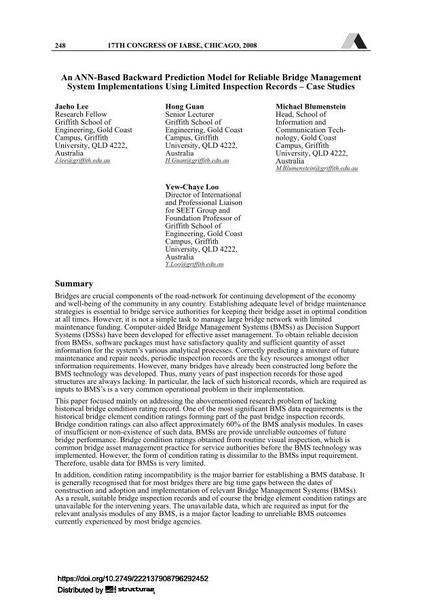An ANN-Based Backward Prediction Model for Reliable Bridge Management System Implementations Using Limited Inspection Records – Case Studies

|
|
|||||||||||
Bibliografische Angaben
| Autor(en): |
Jaeho Lee
Hong Guan Michael Blumenstein Yew-Chaye Loo |
||||
|---|---|---|---|---|---|
| Medium: | Tagungsbeitrag | ||||
| Sprache(n): | Englisch | ||||
| Tagung: | 17th IABSE Congress: Creating and Renewing Urban Structures – Tall Buildings, Bridges and Infrastructure, Chicago, USA, 17-19 September 2008 | ||||
| Veröffentlicht in: | IABSE Congress Chicago 2008 | ||||
|
|||||
| Seite(n): | 248-249 | ||||
| Anzahl der Seiten (im PDF): | 8 | ||||
| Jahr: | 2008 | ||||
| DOI: | 10.2749/222137908796292452 | ||||
| Abstrakt: |
Computer-aided Bridge Management Systems (BMSs) as Decision Support Systems (DSSs) for an effective bridge asset management are used to establish the feasible bridge maintenance, repair and rehabilitation (MR&R) strategies which ensure an adequate level of safety at the lowest possible bridge life-cycle cost. To achieve this goal, keeping up-to-date bridge condition ratings are crucial for a BMS software package. Although most bridge agencies in the past have conducted inspections and maintenance, the form of such bridge inspection records is dissimilar to those required by BMSs. These data inconsistencies inevitably slow down the BMS implementations. This paper presents an Artificial Neural Network (ANN) based prediction model, called the Backward Prediction Model (BPM), for generating unavailable years of historical bridge condition ratings using very limited existing inspection records. The BPM employed historical non-bridge datasets such as traffic volumes, populations and climates, to establish correlations with the existing bridge condition ratings from the very limited bridge inspection records. Such correlations can help fill the condition rating gaps required for an effective and accurate BMS implementation. This paper covers a brief description of the BPM methodology and presents nine case studies. The outcome of this study can help establish a comprehensive condition rating database, which will in turn assist to predict reliable future bridge depreciations. |
||||
| Stichwörter: |
Wartung
|
||||
